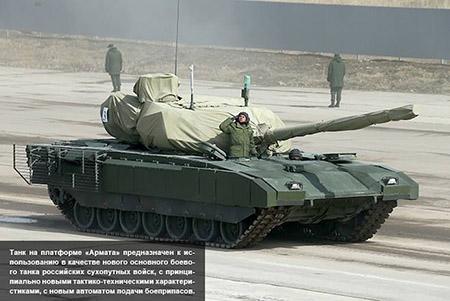The platform produced by Uralvagonzavod was presented a couple of weeks before the Great Parade in Moscow for the seventh anniversary of Victory Day, scheduled for next May.
The new T-14, a monster from 48 tons propelled by a twelve-cylinder diesel engine from 1500 horses that gives it a maximum speed of 90 km / h with autonomy of 500 km, represents a huge technological leap compared to the previous and now obsolete Soviet military equipment in service. The clean lines of the new tank represent the main change from the Russian tradition.
The basic feature of the new MBT is the fully automated turret, equipped with a complete suite of weapon systems. A digitally controlled 12,5 mm heavy machine gun is placed on the roof of the turret.
The three crew members (but can also battle with two) are placed in a sort of armored "capsule" in the front of the hull.
.jpg) The T-14 is armed with a 125 millimeter smoothbore gun that can fire high-powered ammunition including piercing bullets, guided missiles and any type of heavy Russian ammunition designed for MBTs. According to Russian estimates, the 2A82 cannon, believed to hit a target at 8 km, gives a higher kinetic energy than the Rheinmetall from the 120mm of the Leopard-2. Automated loading of 32 shots transported internally is also automated. The 2A82 can shoot up to twelve bullets per minute.
The T-14 is armed with a 125 millimeter smoothbore gun that can fire high-powered ammunition including piercing bullets, guided missiles and any type of heavy Russian ammunition designed for MBTs. According to Russian estimates, the 2A82 cannon, believed to hit a target at 8 km, gives a higher kinetic energy than the Rheinmetall from the 120mm of the Leopard-2. Automated loading of 32 shots transported internally is also automated. The 2A82 can shoot up to twelve bullets per minute.
However, the one shown may not be the ultimate main armament. A few months ago, in fact, the "Koalitsiya-SV" 14S2 was tested on the T-35: system of two superimposed cannons by 152 millimeter (project officially canceled five years ago) capable of firing sixteen strokes per minute. If this device was confirmed, the T-14 might have the most powerful cannons ever installed on a tank.
The turret also houses two 30mm cannons, designed to break down low-altitude aircraft targets, including planes and helicopters.
The T-14 has been designed to survive
Looking at the specifications, Russian designers would seem to have exhausted the Israeli and American theories for armored forces, extending them to the current technology of the new Russian philosophy. For Moscow, the T-14 can defend itself from everything. It is protected by the active Afghan technology, a system that uses a doppler radar to detect incoming bullets, such as grenades and missiles.
Once the projectile has been detected, the defense launches an interceptor rocket to destroy the incoming body. According to Russians, this would be definitive protection against Apache helicopters. According to the US Army, 'Afghanistan' is able to detect only a particular and limited class of grenades and anti-tank threats.
The T-14 is equipped with anti-mine defenses and a suite of high-resolution cameras. These cameras allow the operators of the Armata full awareness to 360 degrees.
The T-14 is protected by the 44S-SV-SH armor designed by the Steel Scientific Research Institute. The particular inclination and composition of the armor (probably an evolution of the 'Kaktus') is estimated in 900 mm at the front. The armor is designed to operate at very low temperatures, an unmistakable sign of the future and massive Russian presence in the Arctic regions.
"Armada" was conceived as a modular universal combat platform that could be used as a base for a series of combat vehicles. The new tank incorporates elements seen in "Object 195" and "Black Eagle" projects.
The T-95 (Object 195) should have been the fourth generation Russian tanker. Announced since 1995, it was considered obsolete with respect to the time when it would have to go into production. The Russian Major Staff canceled the project in May of 2010, preferring to allocate the resources available to modernize T-90.
The capabilities acquired with the T-95 have been implemented in the T-99. The Black Eagle or "Chyorny Oryol" in Russian has probably remained a prototype even though all the information concerning it is classified. We know that its chassis is based on the T-80U, even though the hull is slightly longer. Its frontal armor is a newly developed explosive reactive type. Its code name is "Kaktus" and is considered even more effective (especially for kinetic energy projectiles) than the current third generation reactive armor "Kontakt-5". The Black Eagle also has a “Drozd-2” active protection system, much more effective than the “Arena” system. Finally, the “Black Eagle” mounts a 125mm 2A46 smooth-bore gun with “Atgm” capability.
No other information is known. Within 2020, Russian ground forces will receive 2300 "Armata".
Every single tank has a cost of 400 million rubles, just under 7,4 million dollars.
Franco Iacch
.jpg)












